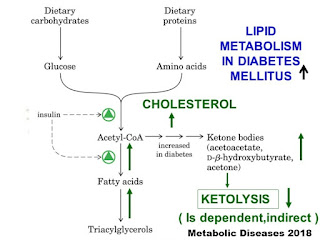Diabetes Contributes to Cholesterol Metabolism

Diabetes mellitus is the most frequent endogenous cause of fat metabolism-disorder. Cholesterol metabolism is abnormal in diabetes. Total plasma cholesterol is increased, and more subtle indices of sterol homeostasis are also disturbed. Hypertriglyceridemia in diabetes is due to an increase of chylomicrons, triglyceride-carrying lipoproteins and the very-low-density lipoproteins. In type I-diabetics the pathogenesis for hypertriglyceridemia is about decreased activity of the lipoproteinlipase, reduced chylomicron-clearance and the impeded degradation of VLDL. More often in non-insulin-dependent diabetics LDL-cholesterol-levels can be seen lifted and HDL-cholesterol-concentration decreased in correlation with the metabolic control. Primary hyperlipoproteinemia shows up regularly in diabetics, but this can be clarified with the association with obesity in type II-diabetics. Dyslipidaemia in T2D is characterised by several strictly linked anomalies: increased fasting and p...



